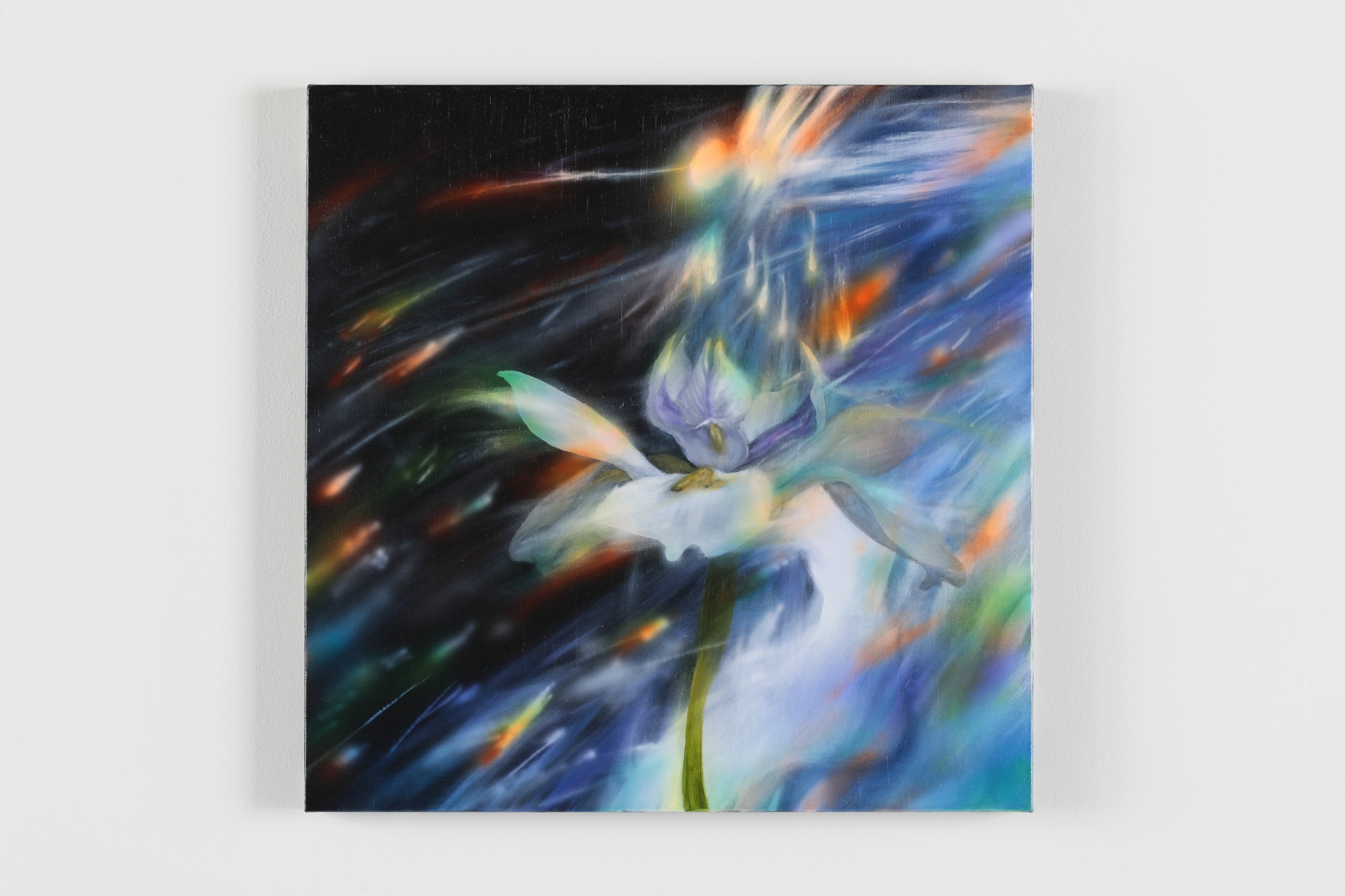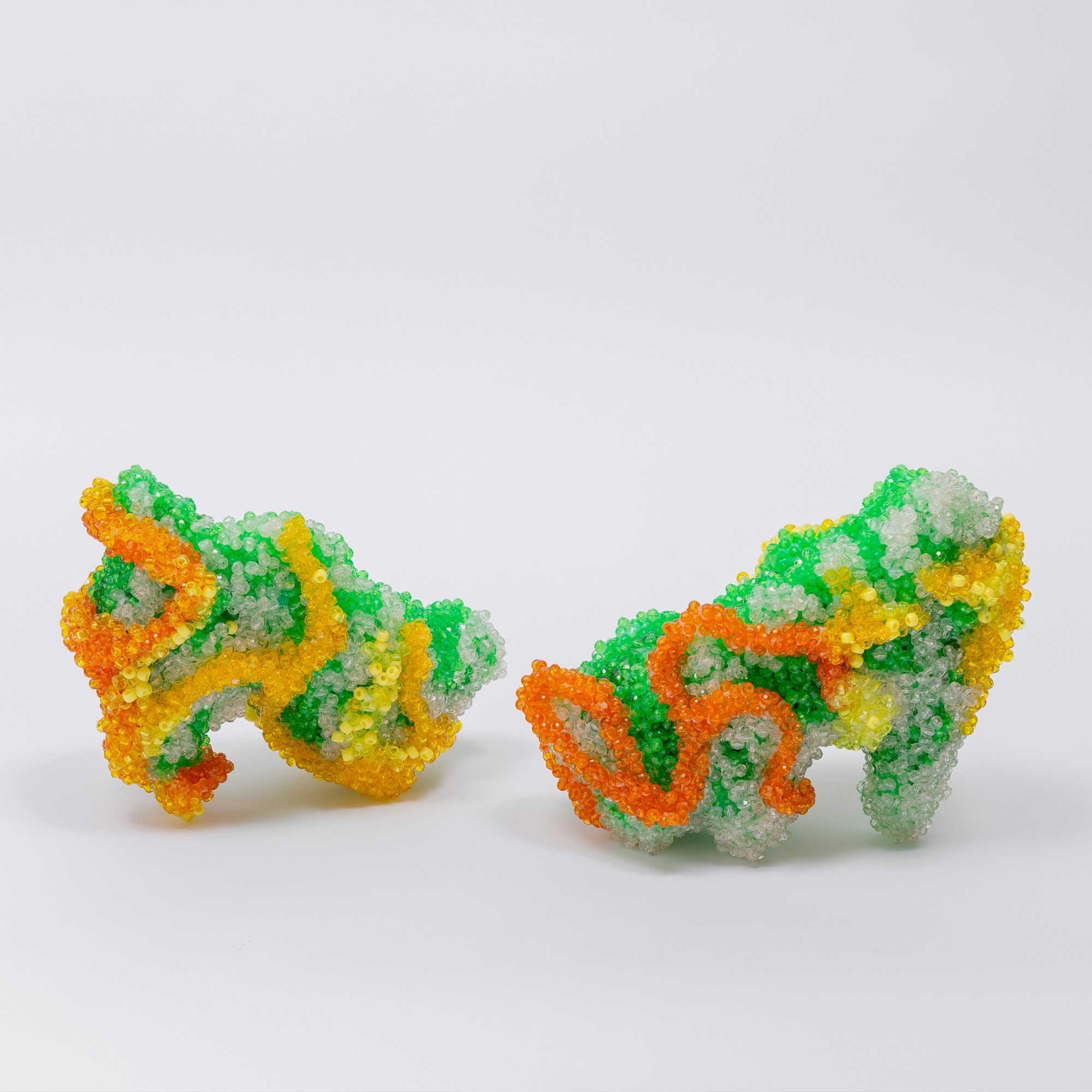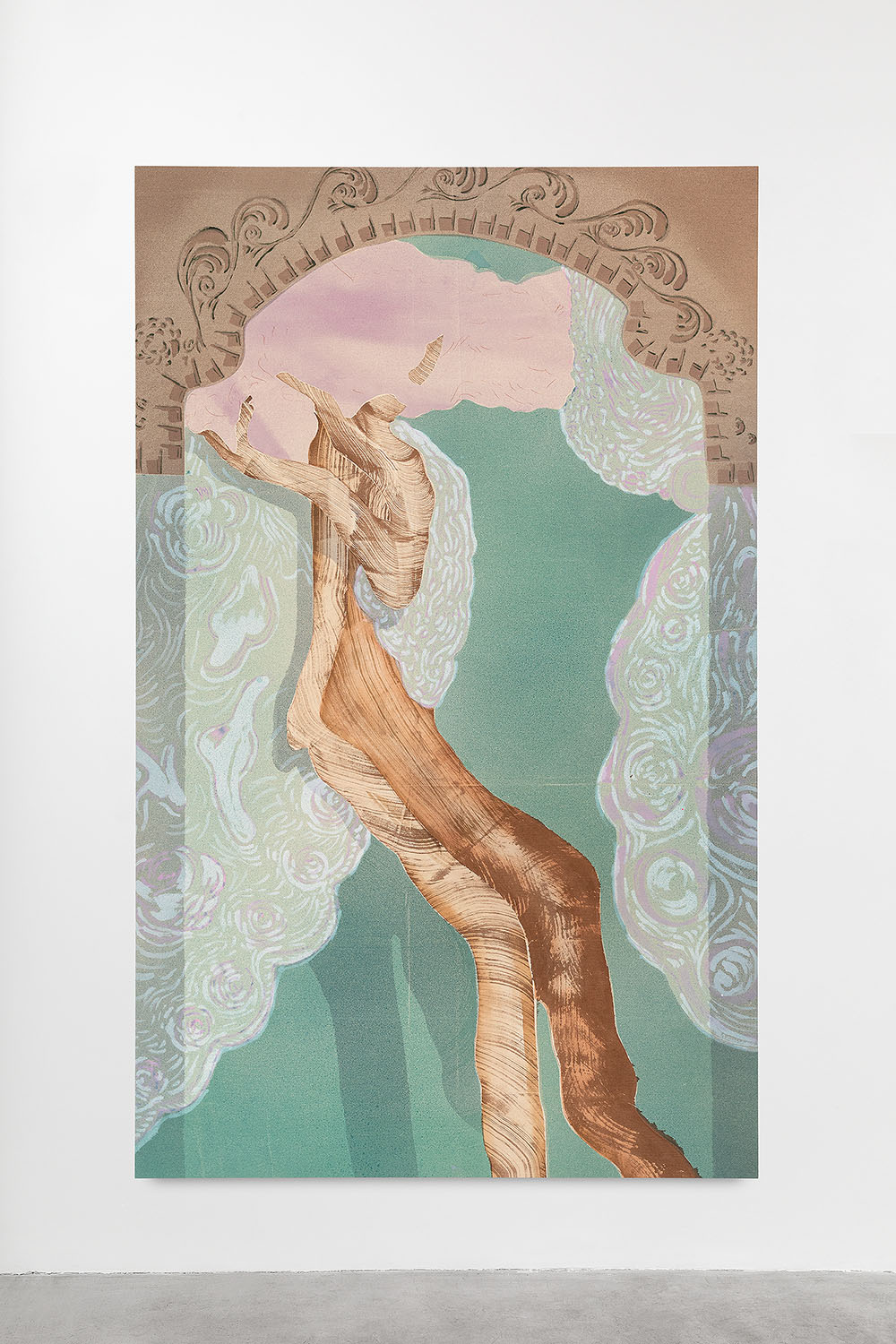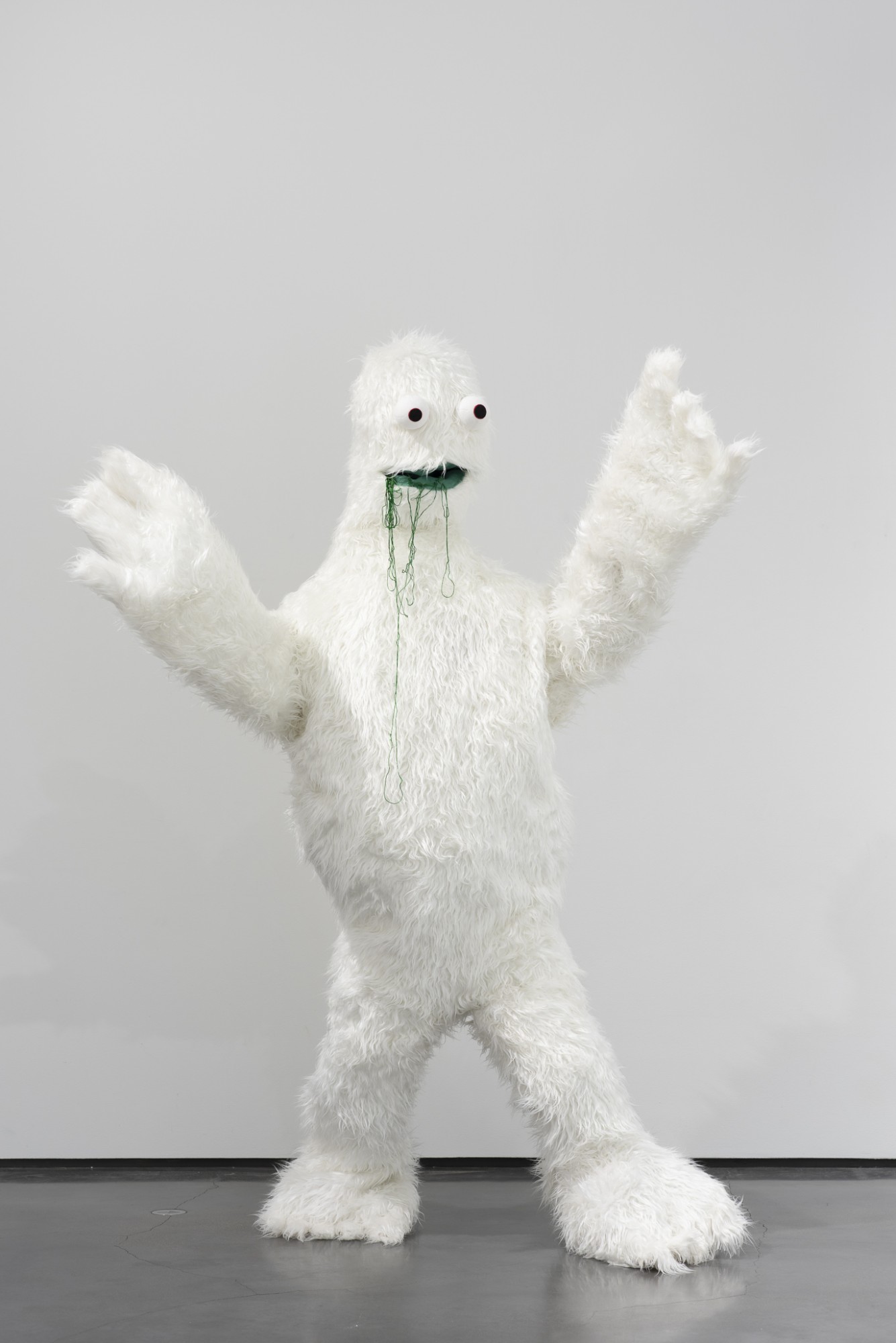FIAC Online Viewing Room 2021
Paris
FIAC OVR 2021
Mar 02, 2021
Mar 07, 2021
CHINO AMOBI
RAÚL DE NIEVES


⇢ Chino Amobi, Seraphim Landing, 2020, Oil, Acrylic, Airbrush on Canvas, 61 x 61 cm (24 1/8 x 24 1/8 in)
Chino Amobi’s Seraphim Landing (2020), part of a series of oil-on-canvas still life paintings of exotic floral species, echoes his accelerated experience traveling and performing throughout the world as a celebrated musician.
Chino Amobi approaches painting with the same vernacular as his music compositions, and vice versa; using sound as a means of immersing the listener into the space of a landscape, envisioning each moment in his musical arrangements as a painting. So too, his paintings frame visions of life bursting forth in a fevered neon dream with sonic vibrations: the exotic bloom a proxy for his entranced audience on the dance-floor, at the height of ecstasy, at the peak of inflorescence.
Born from parents of Nigerian descent in the American south, Richmond, Virginia-based Chino Amobi (b. 1984, Tuscaloosa, Alabama) bridges the fields of contemporary art, electronic music, literature, film and fashion with experimental ease. Working across these platforms enhances the richness of each medium; indistinguishable, they dissolve together in unity within the exhibition space.
Chino Amobi is the co-founder of International Record Label and Art Collective Non Worldwide and the director of Eroica - a thriller in the Epic tradition situated between history and myth.
Forthcoming solo exhibitions include: Fitzpatrick Gallery, Paris (2021), Liste Basel (2021).
Recent solo exhibitions include: Luma Westbau, Schwarzescafé, Zürich (2020); Endeavor Gallery, Richmond (2020).
Recent performances include: Institute of Contemporary Art, Richmond (2019); MOMA, New York (2017); New Museum, New York (2017); ICA London (2017); Museum of Modern Art, Moscow (2017); MOCADA Museum of Contemporary Art of The African Diaspora, New York, et. al. (2016).
⇢ Raúl de Nieves, Soft in Comfort, 2021, Mixed media on shoe, 33 x 36.8 x 19.1 cm (13 x 14 1/2 x 7 1/2 in).
Growing up in the Mexican city of Michoacán, Raúl De Nieves (b. in 1983) was taught to sew and crochet, sparking an early interest in materials not traditionally associated with the paint and clay of fine art. De Nieves relies on the slow, manual labour of stitching and gluing, where patterns of immensely intricate beads and thread sit at the center of his creative world.
He has gained recognition in both the art and fashion worlds, and has often worked with discarded shoes, resulting in pieces that are more fantastical than practical (though still possible) to wear. De Nieves sculpts shoes in intricate beadwork that evoke the appeal of glamour, capturing in a subtle way, the fairytale disguised in fashion. The shoes derive from and are often worn in de Nieves’ performances. These items assume an autonomous significance with the afterglow of the experience.
Soft in Comfort’s beaded structures resemble organic growth patterns found in goede rock crystals or coral. Once the object is pulled apart it reveals a discarded shoe, a seminal resource of his sculptural practice. These foundations would imminently give way to grander representations encompassing the entire human form and diverse exterior environments.
His sculptural shoes have recently been photographed by Mario Sorrenti and Karl Lagerfeld, worn by Lady Gaga, and earned notable press editorials in publications including Vogue Magazine, W Magazine, and Harper’s Bazaar.
Raúl de Nieves (b. 1983, Morelia, Mexico) lives and works in Brooklyn.
Forthcoming solo exhibitions include : ICA Boston (2021); Fitzpatrick Gallery, Paris (2022).
Recent solo exhibitions include: MoCA Miami (2021); SCAD Museum of Art, Savannah (2020); Cleveland Museum of Art, Cleveland (2019).
Recent group exhibitions include: Albright Knox, New York (2021); High Line, New York (2021); Museum of Art and Design, New York (2020); The Museum of Contemporary Art, Los Angeles (2019); K11 Art Foundation, Hong Kong (2019).
MATTHEW LUTZ-KINOY
STEFAN TCHEREPNIN


⇢ Matthew Lutz-Kinoy, Then Back to Paris, 2021, Acrylic on canvas, 250 x 110 cm, (43 1/4 x 98 3/8 in)
Matthew Lutz-Kinoy’s primary medium might be painting, but it often goes beyond two-dimensional space to extend to its surroundings, touching the language of decor or furniture. This expansion of the pictorial space is seen both in the choice of subjects and in the enlarged and repeated stylized motifs. His large format paintings, often installed like decorative tapestries, wall panels or suspended ceilings, stages the exhibition space in which viewers are physically immersed. While the lightness of Lutz-Kinoy’s works flirts with the decorative and moves away from a strong notion of style and “touch”, there is more of a connection to traditions marked by stylistic rules and a pre-established vocabulary: calligraphy, theatre, Japanese ceramics, the Rococo, and the stylized motifs of François Boucher, Jean Cocteau or Balthus.
Matthew Lutz-Kinoy’s painting process is additive. His works are layered, and his application of acrylic evokes printmaking techniques where depth is produced through overlapping, translucent colors. In Then Back to Paris (2021) stenciled layers and cut out shapes float together in a cloud like composition pulling towards the center of the painting. This negative space, shaped like the bend in a turquoise river, is set inside a painted frame with an embellished moulure arch, referencing the artist’s Paris apartment. In an homage to the American painter Florine Stetheimer, Lutz-Kinoy’s painting calls out to imagery of the artist’s hometown New York. Stetheimer ends her poem Then Back to New York with “and what I should like is to paint this thing”; in Lutz-Kinoy’s Then Back to Paris we see a window through which one can access memory, with all its historic depictions, colors and symbols.
Matthew Lutz-Kinoy (b. 1984, New York) lives and works in Paris.
Forthcoming solo exhibitions include: Taka Ishii Gallery, Tokyo (2021); Mendes Wood DM (2021); Fitzpatrick Gallery (offsite project) (2022)
Recent solo shows include: Salon Berlin (2021); Vleeshal, Middelburg (2018); Le Centre d’édition Contemporaine, Geneva (2018); Le Consortium, Dijon (2018); Indipendenza, Rome (2018).
Recent group shows: Geneva Sculpture Biennial, Geneva (2019); FRAC Nouvelle-Aquitaine MÉCA, Bordeaux (2019); MRAC - Musée Régional d‘art Contemporain, Occitanie (20109); Sharjah Biennial 14, Sharjah,(2018); Whitney Museum of American Art, New York (2018); Berliner Festspiele, Berlin (2018); Martin Gropius Bau, Berlin (2018), et. al.
⇢ Stefan Tcherepnin, Slimer, 2020, Faux fur, faux suede, styrofoam, embroidery thread, plastic, wood, 200 x 150 x 40 cm (78 3/4 x 59 1/8 x 15 3/4 in)
Stefan Tcherepnin’s Slimer (2020), the latest monster from his iconic sculpture series, is currently on view as part of Winterfest at the Aspen Art Museum.
Slimer crawls out from underneath a toxic snowdrift in the winter of 2020 in Scandinavia after awakening from a deep and prolonged hibernation. Instinct attracts Slimer to the sea; after gulping down a mouthful of snow, Slimer embarks upon a transatlantic journey in search of living ancestors. Upon reaching the coast of America, Slimer encounters society for the first time. A low hum in the distance draws Slimer inland like an elastic lariat. Slimer traverses forests and flatlands, eventually reaching familiar habitat: banks of snow and lakes of ice. Meanwhile, the hum gains in amplitude and intensity, expanding into a cluster of dark frequencies emanating from a distant mountain slowly coming clearly into view. Upon reaching the foot of the mountain, what appears to be a monument to Slimer’s relatives of yore emits a deafening chord of ecstasy like a foghorn. Descending the slopes of the mountain oozes a slow, thick river of green lava. Slimer takes a lick and it tastes good, warm. Slimer smiles. Slimer’s home.
Stefan Tcherepnin (b. 1979, Boston) recently relocated from Brooklyn to Stockholm.
Forthcoming solo exhibitions include: Platform, Stockholm (2021); Le Consortium, Dijon (2021); Fitzpatrick Gallery, Paris (2022)
Recent solo exhibitions include: Kunsthalle, Zürich (2019); Stedelijk Museum Amsterdam (2018); Freedman Fitzpatrick, Los Angeles (2018); Atlanta Contemporary (2017); Städtische Galerie Delmenhorst (2017)
Recent group exhibitions include: Winterfest, Aspen Art Museum, Aspen (2021); Kanal Centre Pompidou, Brussels (2020); Dépendance, Brussels (2020); Frac Nouvelle-Aquitaine MECA, Bordeaux (2019); Rodeo, London (2019); Lampen, Galerie Francesca Pia, Zurich (2019), Hütti, Ludlow 38, New York (2017).
KANDIS WILLIAMS
⇢ Kandis Williams, Annexation Tango, 2020, Single channel video with sound 10 minutes, 31 seconds, Edition of 3 plus 1 AP (#2/3)
4:3 formatted teaser for “Kandis Williams: A Field”
“Annexation Tango” appears in “Kandis Williams: A Field” at the Institute for Contemporary Art at Virginia Commonwealth University
Kandis Williams | Direction
Brian Echon | Camera & Editing
Patrick Belaga | Sound Score
Olin Caprison/VIOLENCE | Sound Score
Roderick George | Performer
Kevin Lamar Jones | Dramaturgy
Leah Adler | Movement Assistant
Nick Nauhman | Production Assistant
Tyler Lyman| Production Assistant
Departure Point Films | Richmond film Crew
Amber Esseiva | ICA Associate Curator and Liaison
Kandis Williams’ Annexation Tango (2020) is currently on view at the Institute for Contemporary Art in Richmond, as part of her first institutional solo exhibition A Field, which addresses the regimes of control associated with labor.
In the video, the dancer Roderick George performs a tango for one, superimposed on a landscape of photographs and archival footage from the former Lorton Correctional Facility and Virginia State Prison Farm - two facilities where inmates were forced to work as a condition of their sentences - and among plantation-style homes, open fields, and pastures, providing an uncanny convergence of past and present architectures of oppression.
The tango, which arrived to the Americas through the transatlantic slave trade, is shown here as what it was historically: a cathartic dance, a means of escape from the control imposed by systems that seek to classify and manage. In the evolution of movements from the original candombe to the tango we know today, we see a gradual annexation and subsequent erasure of African influence. The only constant in the designation tango has been the negotiations around land, culture, and the body it implies. Thus Williams invites us to reconsider our own conditions, to free ourselves from them in order to respond to our desires for change and adaptation.
Kandis Williams (b. 1985, Baltimore) lives and works in Los Angeles, has an active curatorial and pedagogical practice, and runs Cassandra Press. She is currently a visiting faculty member at the California Institute of the Arts.
Forthcoming solo exhibitions: Luma Foundation, Arles (2021); Night Gallery, Los Angeles (2021); David Zwirner, New York (2021); Fitzpatrick Gallery, Paris (2022).
Current and recent group exhibitions include: Made in L.A. 2020: a version, Hammer Museum Los Angeles (2020-2021); Julia Stoschek Collection, Berlin (2021); Wignall Museum of Contemporary Art (2019); Frye Art Museum (2019); Gladstone Gallery (2017), et. al.